Effect of Different Milling Media for Surface Coating on the Copper Powder Using Two Kinds of Ball Mills with Discrete Element Method Simulation
Abstract
:1. Introduction
2. Materials and Methods
3. Results and Discussion
4. Conclusions
Author Contributions
Funding
Conflicts of Interest
References
- Kim, J.; Satoh, M.; Iwasaki, T. Mechanical-dry coating of wax onto copper powder by ball milling. Mat. Sci. Eng. A 2003, 342, 258–263. [Google Scholar] [CrossRef]
- Bor, A.; Jargalsaikhan, B.; Lee, J.; Choi, H. Surface coating copper powder with carbon nanotubes using traditional and stirred ball mills under various experimental conditions. Particuology 2018, 40, 177–182. [Google Scholar] [CrossRef]
- Kim, H.G.; Park, J.I.; Lee, G.H. Surface coating of Al nanoparticles by using a wet ball milling method: A facile synthesis and characterization of colloidal stability. Curr. Appl. Phys. 2013, 13, 1218–1224. [Google Scholar] [CrossRef]
- Suryanarayana, C. The Science and technology of mechanical alloying. Mater. Sci. Eng. A 2001, 304, 151–158. [Google Scholar] [CrossRef]
- Suryanarayana, C. Recent developments in mechanical alloying. Rev. Adv. Mater. Sci. 2008, 18, 203–211. [Google Scholar]
- Serris, E.; Sato, A.; Chamayou, A.; Galet, L.; Baron, M.; Grosseau, P.; Thomas, G. Dry coating in a high shear mixer: Comparison of experimental results with DEM analysis of particle motions. AIP Conf. Proc. 2013, 1542, 779–782. [Google Scholar] [CrossRef] [Green Version]
- Sato, A.; Serris, E.; Grosseau, P.; Thomas, G.; Galet, L.; Chamayou, A.; Baron, M. Experiment and simulation of dry particle coating. Chem. Eng. Sci. 2013, 86, 164–172. [Google Scholar] [CrossRef] [Green Version]
- Choi, H.; Wang, L.; Cheon, D.; Lee, W. Preparation by mechanical alloying of Al powders with single-, double-, and multi-walled carbon nanotubes for carbon/metal nanocomposites. Comp. Sci. Technol. 2013, 74, 91–98. [Google Scholar] [CrossRef]
- Wang, L.; Choi, H.; Myoung, J.M.; Lee, W. Mechanical alloying of multi-walled carbon nanotubes and aluminum powders for the preparation of carbon/metal composites. Carbon 2009, 47, 3427–3433. [Google Scholar] [CrossRef]
- Carvalho, O.; Miranda, G.; Soares, D.; Silva, F.S. CNT-reinforced aluminum composites: Processing and mechanical properties. Ciênc. Tecnol. Mater. 2013, 25, 75–78. [Google Scholar] [CrossRef]
- Liu, Z.; Xu, S.; Xiao, B.; Xue, P.; Wang, W.; Ma, Z. Effect of ball-milling time on mechanical properties of carbon nanotubes reinforced aluminum matrix composites. Compos. Part A Appl. Sci. Manuf. 2012, 43, 2161–2168. [Google Scholar] [CrossRef]
- Suryanarayana, C. Mechanical alloying and milling. Prog. Mater. Sci. 2001, 46, 1–184. [Google Scholar] [CrossRef]
- Hao, L.; Lu, Y.; Sato, H.; Asanuma, H.; Guo, J. Analysis on energy transfer during mechanical coating and ball milling—Supported by electric power measurement in planetary ball mill. Int. J. Miner. Process. 2013, 121, 51–58. [Google Scholar] [CrossRef]
- Hao, L.; Lu, Y.; Sato, H.; Asanuma, H. Fabrication of zinc coatings on alumina balls from zinc powder by mechanical coating technique and the process analysis. Powd. Technol. 2012, 228, 377–384. [Google Scholar] [CrossRef]
- Singh, A.; Prabhu, T.R.; Sanjay, A.R.; Koti, V. An overview of processing and properties of Cu/CNT nanocomposites. Mater. Today Proc. 2017, 4, 3872–3881. [Google Scholar] [CrossRef]
- Chu, K.; Wu, Q.; Jia, C.; Liang, X.; Nie, J. Fabrication and effective thermal conductivity of multi-walled carbon nanotubes reinforced Cu matrix composites for heat sink applications. Compos. Sci. Technol. 2010, 70, 298–304. [Google Scholar] [CrossRef]
- Liu, P.; Xu, D.; Li, Z.; Zhao, B.; Kong, E.S.-W.; Zhang, Y. Fabrication of CNTs/Cu composite thin films for interconnects application. Microelectron. Eng. 2008, 85, 1984–1987. [Google Scholar] [CrossRef]
- Sato, A.; Kano, J.; Saito, F. Analysis of abrasion mechanism of grinding media in a planetary mill with DEM simulation. Adv. Powd. Technol. 2010, 21, 212–216. [Google Scholar] [CrossRef]
- Weerasekara, N.S.; Liu, L.X.; Powell, M.S. Estimating energy in grinding using DEM modelling. Miner. Eng. 2016, 85, 23–33. [Google Scholar] [CrossRef] [Green Version]
- Amgalan, B. A Study on the Ball Mill Mechanism for Fabrication of Metal-Based Carbon Nanotube (CNT) Nanocomposites during 3 Kinds of a Ball Milling Process with DEM Simulation. Ph.D. Thesis, Changwon National University, Changwon, Korea, 2019. [Google Scholar]
- Bor, A.; Batchuulun, I.; Jargalsaikhan, B.; Lee, J.; Choi, H. Particle morphology behavior and milling efficiency by DEM simulation during milling process for composites fabrication by traditional ball mill on various experimental conditions—Effect of rotation speed, ball size, and ball material. Korean Chem. Eng. Res. 2018, 56, 191–203. [Google Scholar] [CrossRef]
- Burmeister, C.; Titscher, L.; Breitung-Faes, S.; Kwade, A. Dry grinding in planetary ball mills: Evalution of a stressing model. Adv. Powd. Technol. 2018, 29, 191–203. [Google Scholar] [CrossRef]
- Jayasundara, C.T.; Yang, R.Y.; Yu, A.B.; Rubenstein, J. Effects of disc rotation speed and media loading on particle flow and grinding performance in a horizontal stirred mill. Int. J. Miner. Process. 2010, 96, 27–35. [Google Scholar] [CrossRef]
- Sim, C.H. Effect of grinding media on grinding of ball mill. J. Ceram. Eng. 1995, 10, 87. [Google Scholar]
- Jayasundara, C.T.; Yang, R.Y.; Yu, A.B. Effect of the size of media on grinding performance in stirred ball mills. Miner. Eng. 2012, 33, 66–71. [Google Scholar] [CrossRef]

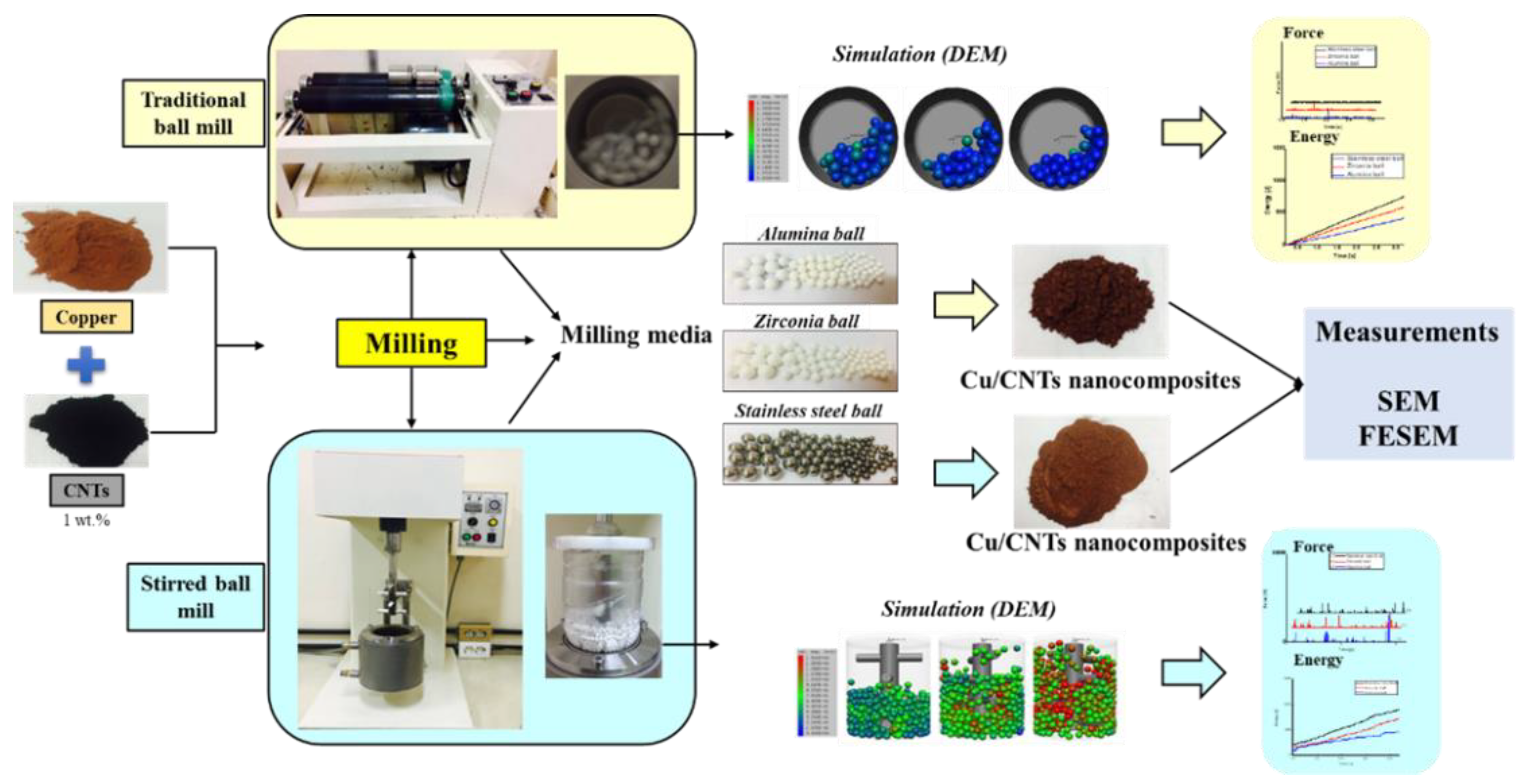
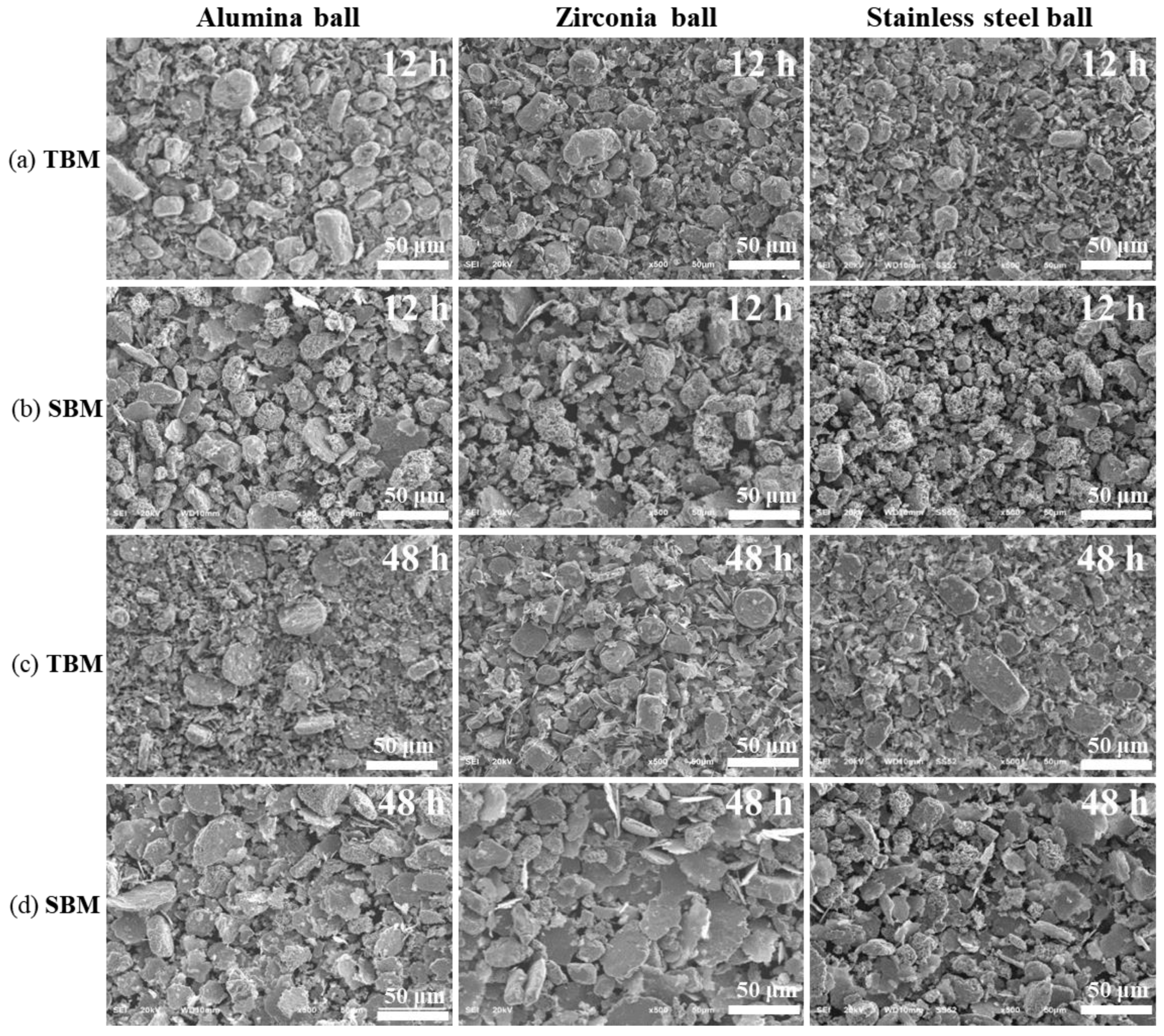
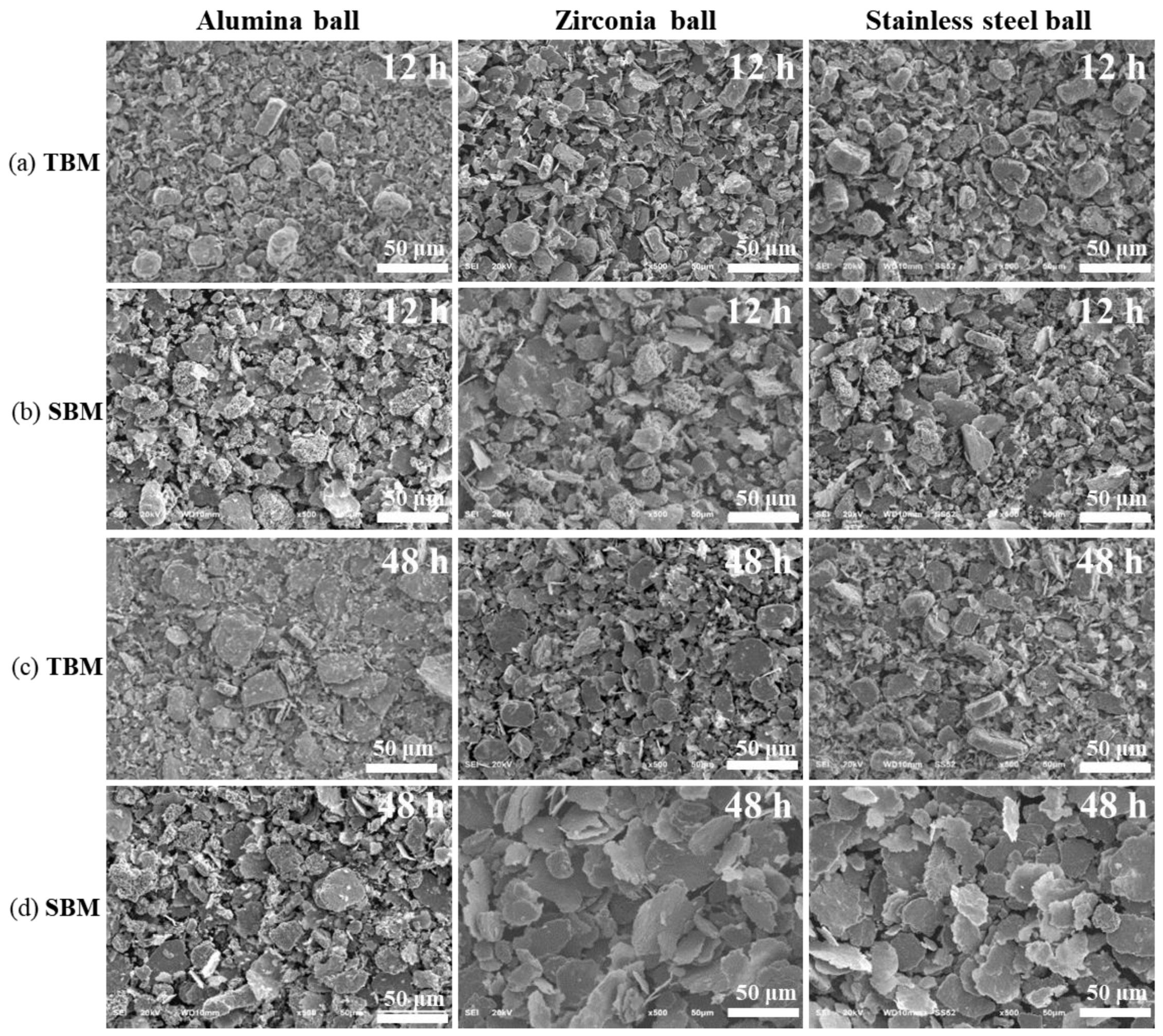



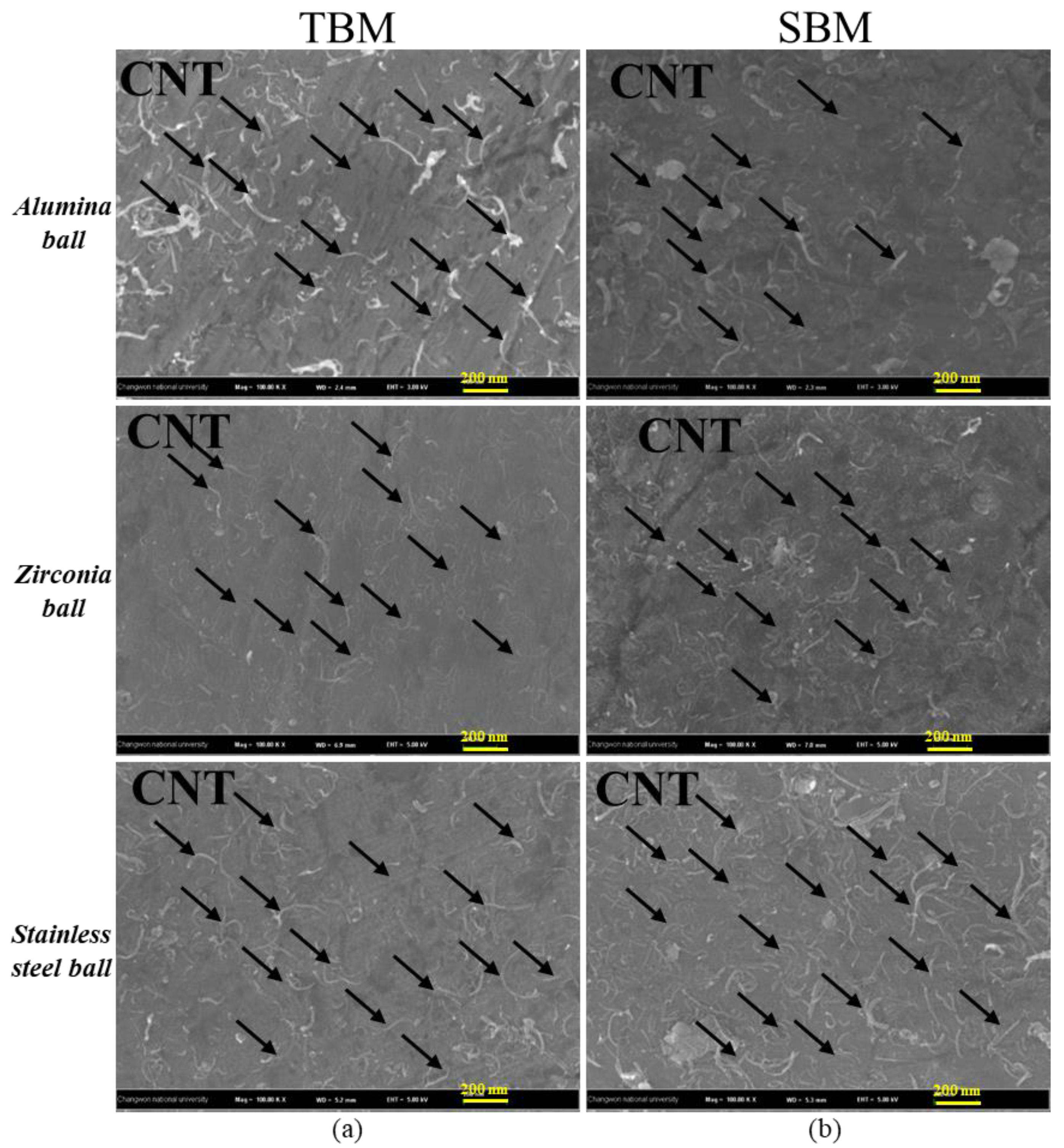
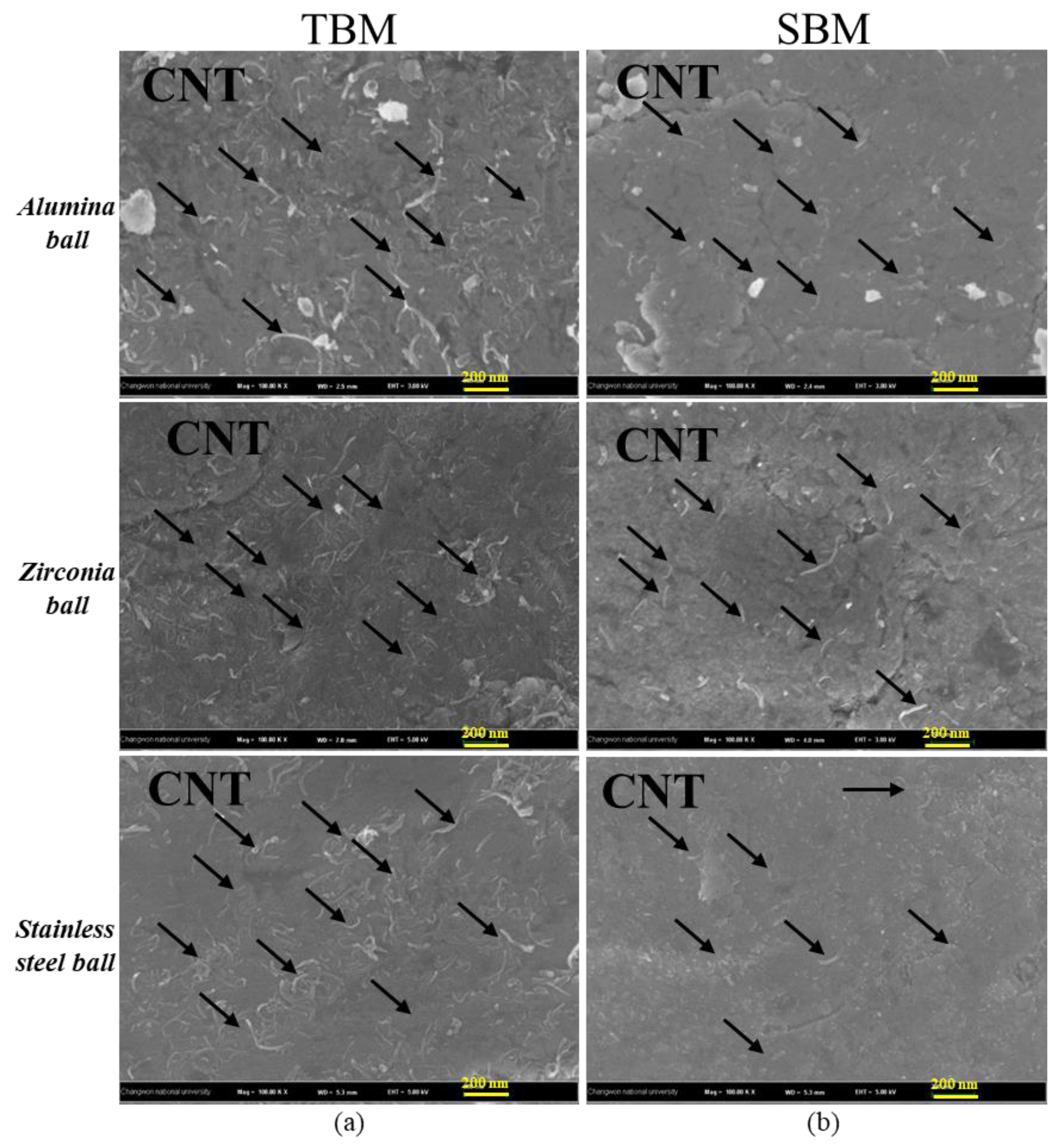

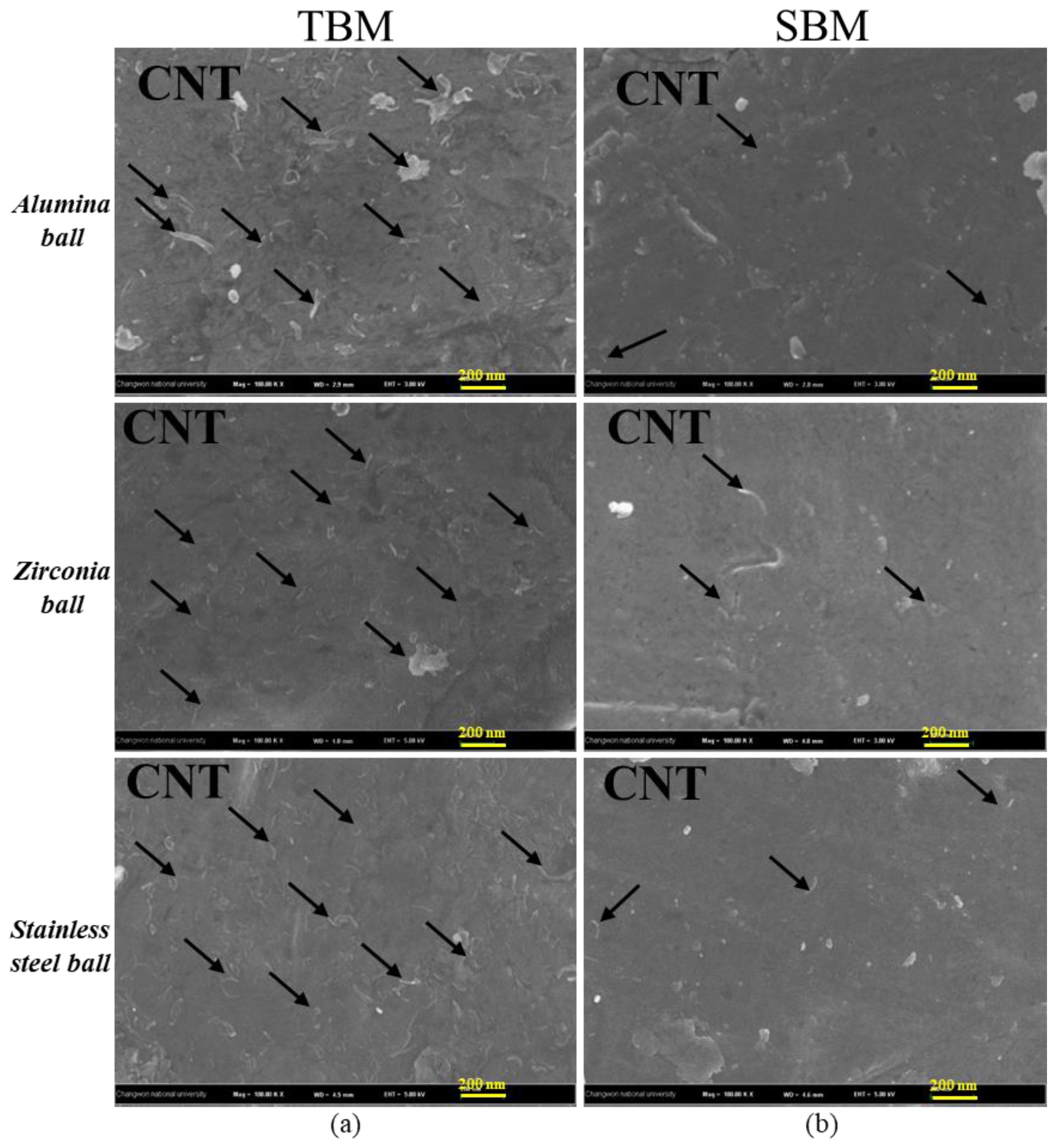


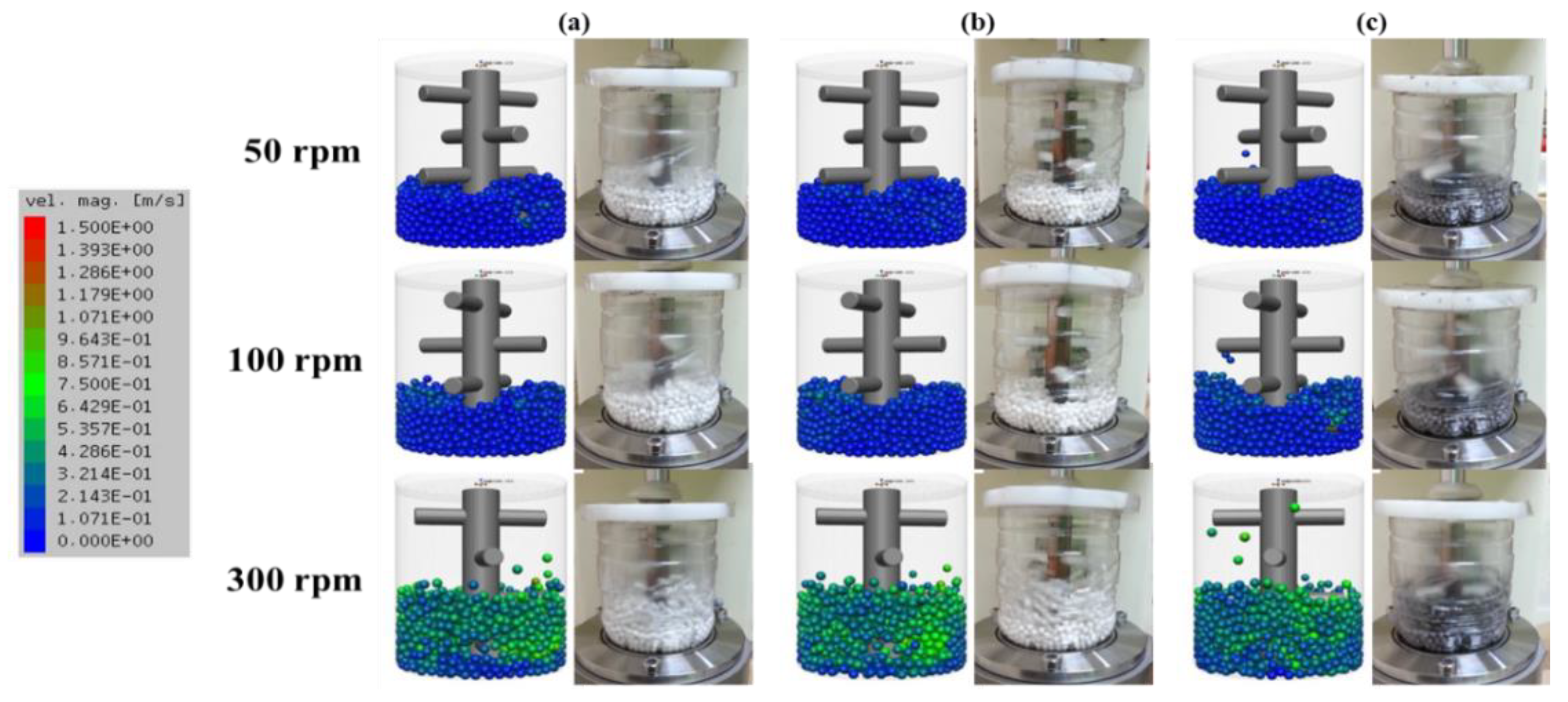


| Coating Experimental Conditions | TBM/SBM |
|---|---|
| Revolution speed (rpm) | 50, 100 and, 300 |
| Ball size (mm) | 5 |
| Milling time (h) | 12/48 |
| Ball powder ratio | 10:1 (fixed) |
| Ball filling ratio [-] | 0.3 (fixed) |
| Amount of CNTs [wt%] | 1 |
| Ball material | Alumina, Zirconia, and Stainless-steel ball |
| Temperature | Room temperature |
| Simulation Conditions | TBM | SBM | ||
|---|---|---|---|---|
| Ball to Ball | Ball to Wall | |||
| Friction coefficient (-) | Alumina media | 2.0 | 0.1 | 0.9 |
| Zirconia media | 1.0 | 0.5 | 0.8 | |
| Stainless steel media | 0.3 | 0.1 | 0.7 | |
| Revolution speed (rpm) | 50, 100, 300 | |||
| Ball size (mm) | 5 | |||
| Number of the media | 5 mm | 99 | 1490 | |
| Density of media [g/cm3] | alumina | 4.36 | ||
| zirconia | 6.22 | |||
| stainless steel | 7.95 | |||
| Ball filling ratio [-] | 0.3 | |||
| Young modulus [MPa] | 200,000 | |||
| Poisson’s ratio | 0.3 | |||
| Thermal conductivity [W/m K] | 3.5 | |||
| Revolution Speed (rpm) | Ball Type | TBM | SBM |
|---|---|---|---|
| Total Force (N) | |||
| 50 | Alumina ball | 250 | 15,534 |
| Zirconia ball | 225 | 13,292 | |
| Stainless steel ball | 280 | 16,758 | |
| 100 | Alumina ball | 265 | 28,712 |
| Zirconia ball | 277 | 29,451 | |
| Stainless steel ball | 339 | 33,402 | |
| 300 | Alumina ball | 301 | 64,597 |
| Zirconia ball | 307 | 65,538 | |
| Stainless steel ball | 338 | 68,088 | |
© 2020 by the authors. Licensee MDPI, Basel, Switzerland. This article is an open access article distributed under the terms and conditions of the Creative Commons Attribution (CC BY) license (http://creativecommons.org/licenses/by/4.0/).
Share and Cite
Bor, A.; Jargalsaikhan, B.; Lee, J.; Choi, H. Effect of Different Milling Media for Surface Coating on the Copper Powder Using Two Kinds of Ball Mills with Discrete Element Method Simulation. Coatings 2020, 10, 898. https://doi.org/10.3390/coatings10090898
Bor A, Jargalsaikhan B, Lee J, Choi H. Effect of Different Milling Media for Surface Coating on the Copper Powder Using Two Kinds of Ball Mills with Discrete Element Method Simulation. Coatings. 2020; 10(9):898. https://doi.org/10.3390/coatings10090898
Chicago/Turabian StyleBor, Amgalan, Battsetseg Jargalsaikhan, Jehyun Lee, and Heekyu Choi. 2020. "Effect of Different Milling Media for Surface Coating on the Copper Powder Using Two Kinds of Ball Mills with Discrete Element Method Simulation" Coatings 10, no. 9: 898. https://doi.org/10.3390/coatings10090898
APA StyleBor, A., Jargalsaikhan, B., Lee, J., & Choi, H. (2020). Effect of Different Milling Media for Surface Coating on the Copper Powder Using Two Kinds of Ball Mills with Discrete Element Method Simulation. Coatings, 10(9), 898. https://doi.org/10.3390/coatings10090898




